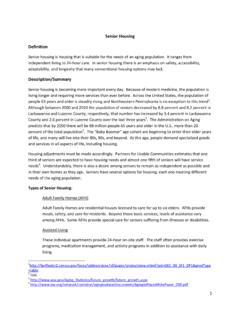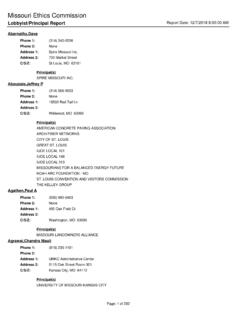Transcription of Mixed Use Development Definition - nepahousing.org
1 A partnership among Keystone College, King's College, Luzerne County Community College, Marywood University, Misericordia University, Penn State Wilkes-Barre, The Commonwealth Medical College, University of Scranton & Wilkes University May 2013 Mixed Use Development Definition Mixed use Development is the use of a building or set of buildings for more than one purpose. Instead of single use Development that can only serve one purpose, Mixed use Development can combine commercial, industrial, and residential uses on one property. This type of Development has become more plausible as most industry has moved out of cities.
2 Commerce has become cleaner and the need for separation between these and residential areas has lessened. Description/Summary Mixed use areas can bring a number of benefits. They have the potential to become a town center and truly revitalize part of a city. Mixed use buildings are also more sustainable and efficient structures. Because Mixed used buildings combine several uses, consumers may save time and travel expenses by satisfying multiple needs in a single location. Building tenants also benefit from reduced costs due to shared utilities and more customers due to increased walking traffic.
3 However, it can be difficult to attract developers to Mixed use zoning projects because of higher Development costs attributable to many factors. Planning costs are higher because of the complexity of a structure that incorporates many uses. Builders may also need multiple approvals from local authorities for each use. Also, land that is suited for Mixed use is typically sold at a higher price than single use Hence, such Development has the greatest impact when it includes a residential component. Mixed buildings are usually constructed in urban areas where transportation is easily accessible; this is ideal, as it makes the property most efficient.
4 Benefits of high density 1. RABIANSKI, P. D. ( ). Retrieved from 1 Development include, reductions in energy use, greenhouse gas emissions, and traffic congestion that flow from lower car usage .2 By increasing density, municipalities can save on infrastructure costs; this is because Mixed buildings attract more of the population into the city where utility infrastructure and resources already exist. Mixed use Development can also attract residents to the places where resources can be used most easily. This can aid municipalities that are concerned with sustainability. Cities are also attracted to the idea of Mixed zoning from a fiscal perspective.
5 Higher density not only means that utilities are being used efficiently, it can also ensure an optimal level of tax revenue from land use. Since multiple services are occupying one space, tax revenue can be raised from many sources on one property. Joseph Minicozzi of Urban3, LLC gave examples from his research in Asheville, North Carolina, where his firm compared the property tax generated by a Super Wal Mart on the edge of the city with a typical acre of Mixed use Development in Asheville's downtown district. The Wal Mart consumed acres and generated property taxes of $47,500 per acre, while the Mixed use Development consumed only acres and generated $634,000 in property taxes per acre.
6 A sample set of 15 cities from Montana to Florida provided similar results, underlining the economic potential of creating Mixed . use developments on Main Streets, vibrant neighborhood hubs, or central business districts in communities across the Thus, Mixed use zoning makes sense from a fiscal standpoint as well as a sustainability and efficiency perspective. One of the biggest challenges for Mixed use Development is parking. A Mixed use building that serves many purposes is likely to attract many people living working, and visiting it daily. Thus, supplying sufficient parking is an important part of planning for a Mixed use building.
7 A downfall of constructing parking facilities is the cost, which can be discouraging to many investors. Zoning code requirements can also make Development difficult. The Smart Growth Leadership Institute examined a California case study and came up with a few recommendations. First, it recommended cities conduct financial feasibility analyses to determine whether the project will make economic sense for developers. It also stressed a marketing plan and fee waivers to attract high quality developers to the property. The Smart Growth Leadership Institute further encouraged cities to consider financial assistance for 2.
8 "Affordable, compact and well located housing is critical to achieving the nation's transportation policy objectives." National Housing Conference. Center for Housing POlicy, 3. " Mixed Use Development Makes More Cents for Cities : Center for Neighborhood Technology. "Sustainable Communities Attainable Result, 17 May 2012. Web. 19 Apr. 2013. 2 affordable housing for the Moreover, it advised cities to have predetermined and strict requirements for developers to meet so that authorities do not have to review each case individually. The study predicts that this will result in an easier process for both developers and the municipality.
9 However, as discussed earlier, planning and permit costs are already high for developers. Thus, the creation of strict standards is something that should be carefully considered by the municipality and it should ensure that those standards are not overwhelming for developers who are already facing challenges. Strategies/How to When planning a Mixed use project, it is essential to pick a team that has experience with these types of developments. The team should be a group of people that first gather information from a variety of sources, such as, leasing agents, property managers, market experts, financial analysts, capital providers, marketing consultants, major tenants, Development partners, construction contractors, public officials, and surrounding community It is also very important that both financial and non financial goals are clearly identified from the initiation of the project so the team has guidelines and a structure to follow.
10 It is equally important that the team conducts a market analysis of the project since different geographies and market areas vary. Likewise, each use must be analyzed with regard to its own supply and demand situation and should be able to attract sufficient market demand to make it financially possible in its own Furthermore, the developer should consider the potential market synergies from on site support. The first type of market synergy is derived from direct on site market support; this would include residents, office workers, and hotel guests frequenting the retail and restaurant components of the project.



